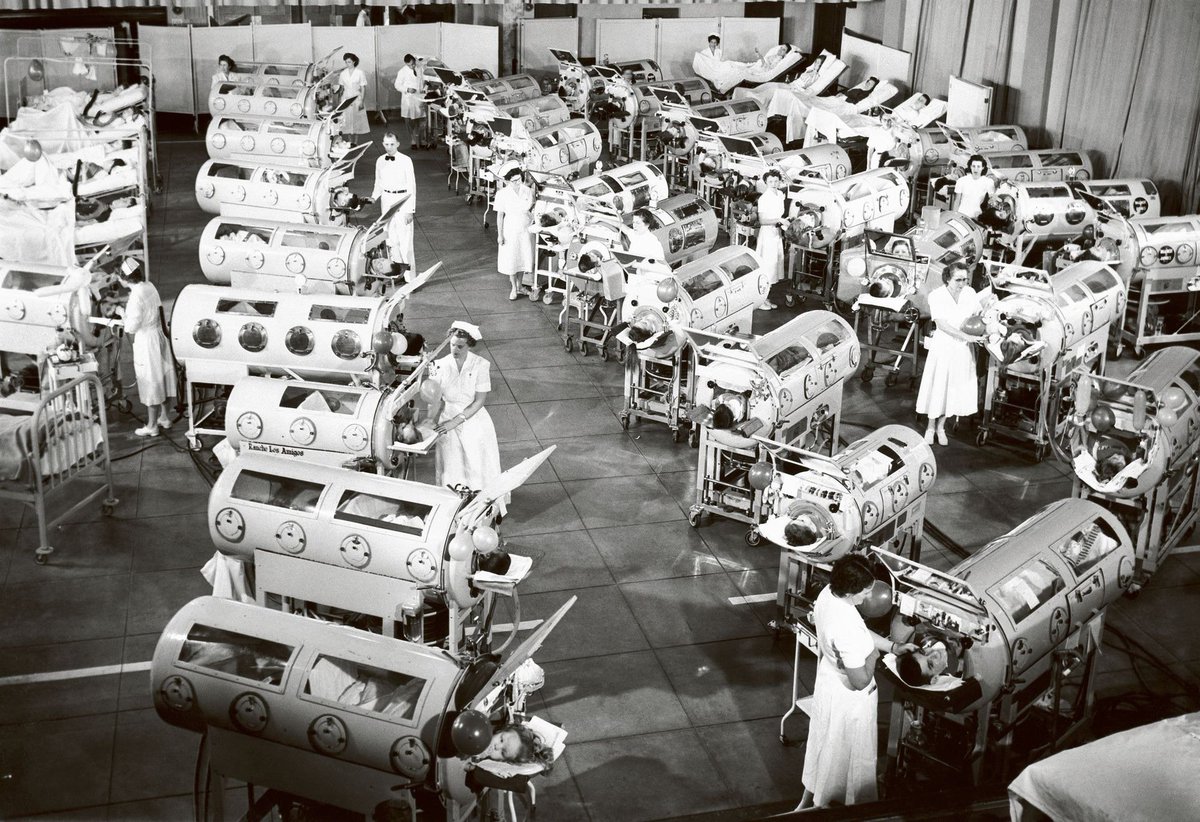1. If you want to understand what causes Crohn’s disease, ulcerative colitis, or actually many other chronic illnesses, and why most medicine doesn’t seem to treat it, I want to explain what may be happening. (thread)
#crohnsdisease #ulcerativecolitis #ibd #chronicillness #crohns
#crohnsdisease #ulcerativecolitis #ibd #chronicillness #crohns
2. This hypothesis is a collaboration between my wife and I, and is based on longstanding research + some new studies that have come out in the last year or so.
3. Crohn’s disease is a chronic inflammatory condition of the gastrointestinal tract. Like many of the other inflammatory bowel diseases, it can be a debilitating illness that makes life a living hell. If it gets bad enough, it can kill.
4. Ulcerative colitis is diagnosed on similar inflammation, but in a specific part of the GI tract—the bowel and colon. Crohn’s can be very destructive as it can move anywhere around the entire GI tract. 

5. If you look online for what might be causing either of these diseases, you will find nothing. Scientists and doctors don’t know why 1.4 million people in the U.S. develop this debilitating inflammation in their intestines. 

6. Crohn’s has not always been with us. Officially, it is listed as being discovered in 1932. A few references to similar symptoms can be found earlier, but like many other illnesses, it appears to have never existed before the 1800s.
7. After years of research, my wife and I have been able to come up with a good idea as to what’s causing these diseases and why conventional medicine hasn't worked very well.
8. One of the hallmarks of Crohn’s disease is that it almost always starts in a very specific place—the terminal ileum. The terminal ileum is where your small intestine connects to your large intestine. 
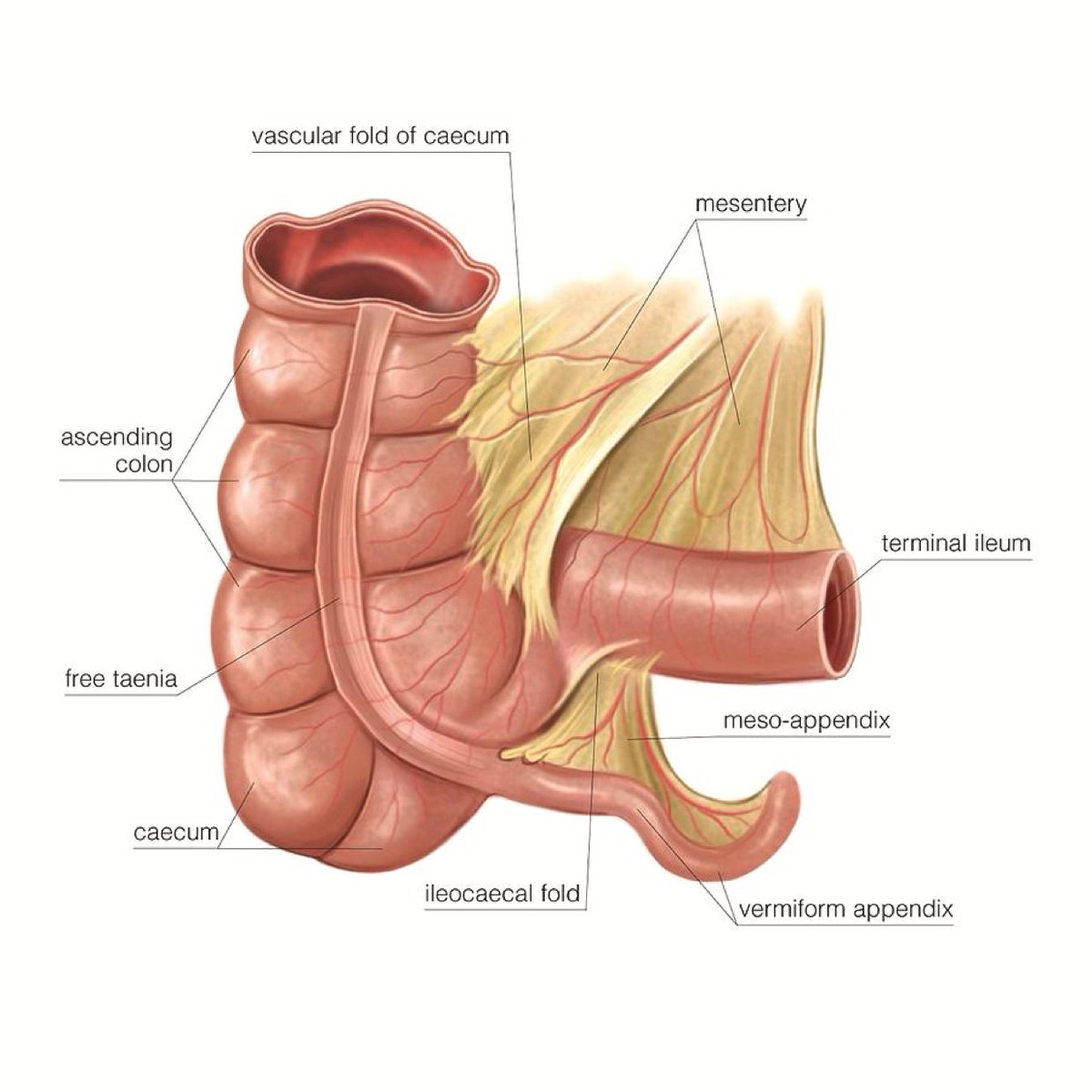
9. Why this specific location? What is so special about that part of your intestine? It ended up being a big clue to the possible cause of these diseases, but one that even most GI specialists won’t know anything about.
ncbi.nlm.nih.gov/pubmed/21172238
ncbi.nlm.nih.gov/pubmed/21172238
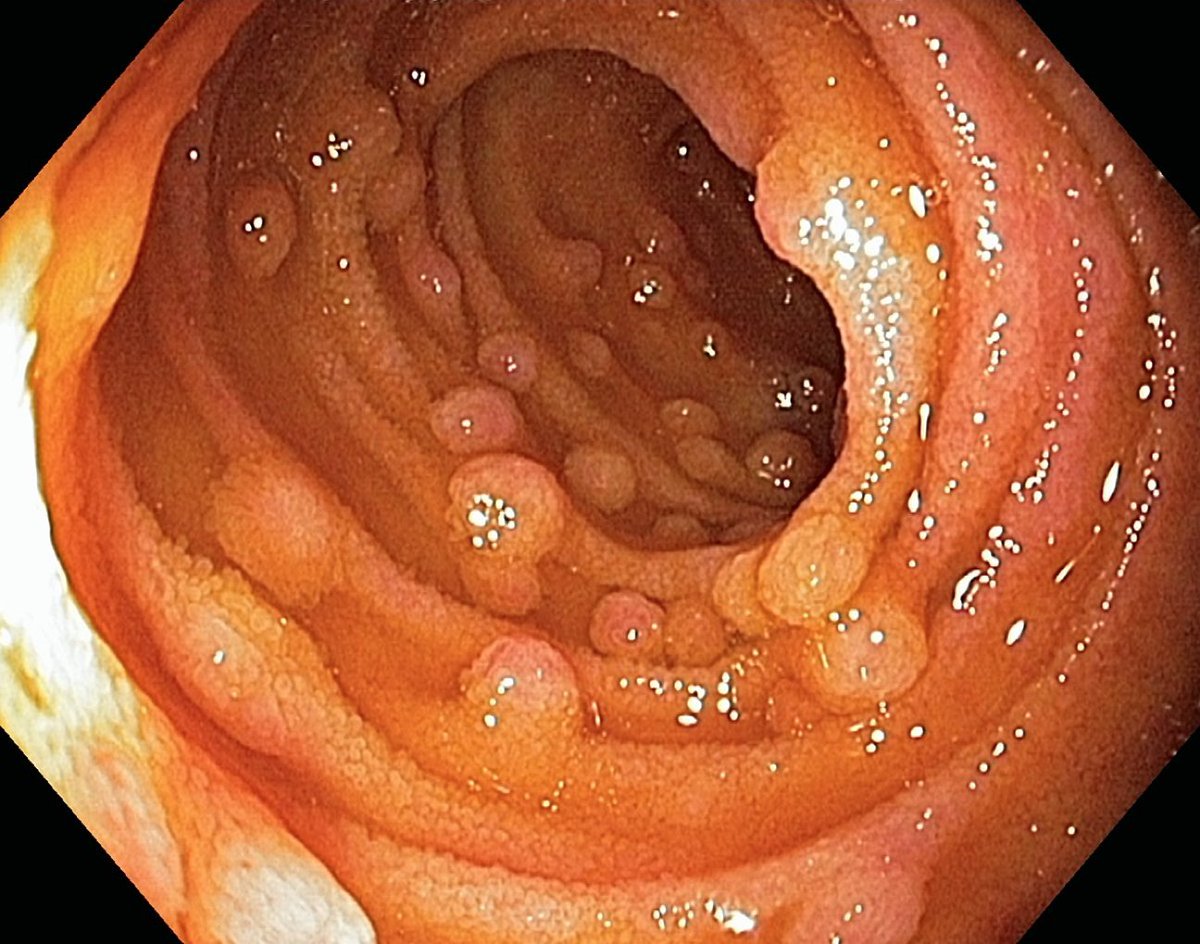
10. It’s been clear to scientists for quite a while that there’s some type of microbial component to Crohn’s.
11. As far back as 1992, bacterial cultures were taken from those suffering from Crohn’s & a common culprit was discovered: Mycobacterium avium paratuberculosis.
gut.bmj.com/content/gutjnl…
gut.bmj.com/content/gutjnl…

12. These bacteria, called Myco for short, were injected into rabbits who developed inflammation in their ileum—the same spot where Crohn’s often starts in humans. Researchers thought they had isolated the bacteria that was causing Crohn’s disease.
13. But there was a problem—Myco infections weren’t consistent. They didn’t ALWAYS cause this horrible inflammation. People who previously had Crohn’s disease could have active Myco bacteria in their blood but show few signs of active inflammation in their gut.
14. Scientists were understandably confused, and Myco bacteria faded into the background because it didn’t consistently create the inflammation of Crohn’s disease.
15. An older study gave us a clue as to what was happening.
In that study, the bacteria Streptococcus fecalis was placed into rabbit ileum & failed to develop any of the symptoms of Crohn’s.
In that study, the bacteria Streptococcus fecalis was placed into rabbit ileum & failed to develop any of the symptoms of Crohn’s.
16. In the same study, the experiment was repeated with a special form of the same bacteria called the intracellular form. This time, the results were unmistakable—inflammation, just like Crohn’s.
17. Intracellular bacteria are very difficult to study but we believe they are the key to many of the modern, mysterious, unexplainable diseases so many suffer from.
18. Intracellular bacteria have lost their cell wall for some reason. They are difficult to detect and can reproduce inside your white blood cells, like viruses. This makes it VERY difficult for your immune system to control.
19. The infections from intracellular bacteria can go on for months—even years—and we believe can cause the chronic inflammation seen in many different diseases: Chronic Lyme, Rheumatoid Arthritis, Fibromyalgia, Chronic Fatigue, and many others.
20. Intracellular bacteria are not typically a naturally occurring phenomenon, but are created by something unnatural.
21. Certain antibiotics can cause this, & in fact, are DESIGNED to do this. Basically, they strip the cell wall from bacteria to prevent them from reproducing.
sigmaaldrich.com/technical-docu…
sigmaaldrich.com/technical-docu…
22. Occasionally, when the wrong antibiotic meets the wrong bacteria, bad things happen. A common problem is when the penicillin-family of antibiotics is used against strep. Sometimes it works fine. Other times not so much.
23. Unfortunately, it’s all too common to hear about a strep infection that’s treated with penicillin-family of antibiotics and it spirals out of control. It could become rectal strep. Sometimes full-blown PANDAS.
medicinenet.com/pandas/article…
medicinenet.com/pandas/article…
24. This poor kid is suffering from a mild case of PANDAS. PANDAS stands for Pediatric Autoimmune Neuropsychiatric Disorders Associated with Streptococcal Infections. Normally, strep infections don’t cause this.
25. Other kids don’t get videos on YouTube—because their symptoms are too horrible. The video description says “thank we were able to get him on antibiotics, but the tics still return.” Antibiotics may have started the whole problem. MAY.
26. Incidentally, I think this actually explains the penicillin “allergy” that some people have. It’s not allergy at all, but simply the inflammation from a raging intracellular bacterial infection many people get after taking this particular antibiotic.
27. I talk more about this phenomenon of poor antibiotic choice, PANDAS, allergies, and many other issues in my book, Crooked:Man-Made Disease Explained.
amazon.com/Crooked-Man-Ma…
amazon.com/Crooked-Man-Ma…
28. Antibiotics aren’t the only things that can create intracellular bacteria. Irradiating food, microwaves, and pasteurized milk can also cause this problem. But there is another thing that we fear may be the most frequent cause of intracellular bacteria.
29. The thing we’re really afraid may be causing intracellular bacteria are metals inside the body. Particularly aluminum. 
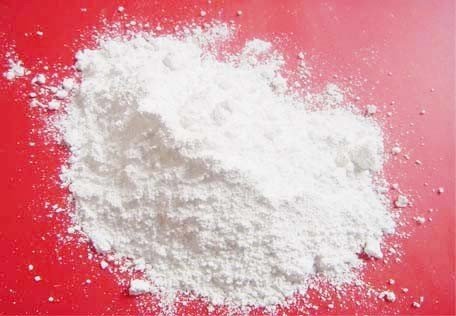
30. Why do we think it’s aluminum? Let’s go back to Crohn’s disease. If Crohn’s really is just an intracellular bacterial infection that your body’s immune system can’t get rid of, why does it almost always start in the terminal ileum?
31. As it turns out, the terminal ileum has a special purpose: it contains a unique type of intestinal tissue called Peyer’s patches. 

32. Peyer’s patches are kind of like the tonsils and adenoids of the gut—they help the immune system identify invaders in your intestine. Unfortunately, they also tend to accumulate another type of invader—aluminum.
33. Multiple studies have confirmed that aluminum tends to accumulate in Peyer’s patches in the terminal ileum of your intestines.
ncbi.nlm.nih.gov/pubmed/3817799
ncbi.nlm.nih.gov/pubmed/3817799
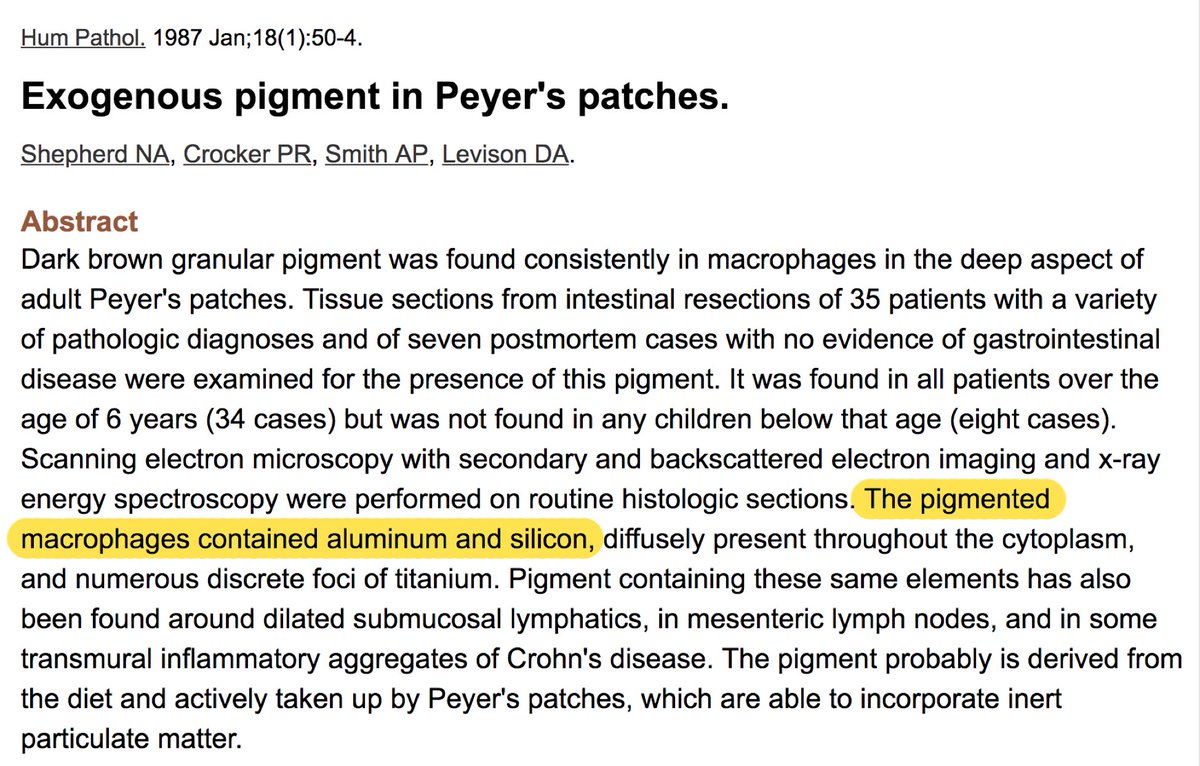
34. It would be an amazing coincidence that out of 28 feet of small and large intestine, the tiny area where Crohn’s originates also contained a very special lymphatic component that tends to collect aluminum.
35. The unlikelihood of such a coincidence hasn’t gone unnoticed, & researchers have replicated how aluminum can cause the inflammation seen in Crohn’s disease.
journals.sagepub.com/doi/abs/10.117…
journals.sagepub.com/doi/abs/10.117…

36. And another look at the potential role of Aluminum in Crohn’s Disease:
onlinelibrary.wiley.com/doi/abs/10.109…
onlinelibrary.wiley.com/doi/abs/10.109…

37. Remember, Myco bacteria in their normal state apparently can’t cause the inflammation of Crohn’s. But get them into their intracellular state… Boom. Fistulas. Ruptures. Blockages. And worse.
38. Perhaps this is why aluminum has been shown in other animals to “decrease mucosal healing.”
nature.com/articles/mi201…
nature.com/articles/mi201…
39. Many scientists have studied the association between aluminum and inflammatory bowel diseases like Crohn’s. Other scientists have pondered the possible role of intracellular bacteria and Crohn’s.
40. This is what we’re proposing: Because we know that aluminum accumulates in the terminal ileum—where Crohn’s almost always starts, and we know that intracellular bacterial infections can cause the inflammation of Crohn’s…
41. …we believe the aluminum that collects in the Peyer’s patches in your terminal ileum—a place where bacteria ALSO tend to gather—is creating intracellular forms of certain bacteria in your gut. Likely Myco. Possibly others.
42. This collision of bacteria and aluminum creates a raging gut infection your body cannot clear. The resulting inflammation is what doctors call Crohn’s disease.
43. The millions of bacteria in your intestines normally limit the infection to that specific area of your gut. Sometimes, with enough stress, poor food choices, etc. the infection will spread out further, causing more damage.
44. Your body can occasionally get on top of the infection, and the inflammation of Crohn’s may go away—seemingly completely. But then a triggering event that supplies more aluminum to your body (or a random bacterial infection) may create the conditions for Crohn’s.
45. Of course genetics plays some role in determining whether you are predisposed to this phenomenon or not, but we believe that absent any antibiotics, metals like aluminum, or other intracellular bacteria triggers, Crohn’s disease would never happen.
46. This is why it is a “new” disease that basically didn’t exist two hundred years ago. Before antibiotics or metals were a problem, these intracellular infections never caused a problem.
47. Most of the best modern medicine we have available attempts to suppress the inflammation of Crohn’s disease. Suppressing inflammation is obviously not addressing the root of the problem, but doctors feel like they have few other options.
48. Modern treatments are available—though obscure—and work to help the body clear these intracellular infections. We’re getting better at understanding how to do this all the time. Help is on the way!
49. We are also improving our ability to get rid of any aluminum you may currently have in your body. A giant first step would to remove any sources of aluminum in your life.
50. Dietary aluminum can be a problem, as can certain anti-perspirants or cookware. The single most dangerous source of aluminum in most people’s lives is often from vaccines.
51. Although humans ingest a small amount of aluminum in their diet, only about .3% of it is actually absorbed into the body. Ingested aluminum is in an ionic form that is easily filtered by the kidneys.
52. The aluminum that is injected is in a different form called nanoparticulates. This form of aluminum is much different than the ingested kind and creates a couple of problems you will never see with the dietary kind.
53. Anyone who tells you that injected aluminum is not dangerous because it’s far less than the amount contained in fish, or formula, or any other dietary source doesn’t understand how the body deals with injected aluminum.
54. Besides injected aluminum being much more dangerous than dietary aluminum, an astonishing discovery was made recently—less aluminum is worse. Yes, LESS is worse than MORE.
sciencedirect.com/science/articl…
sciencedirect.com/science/articl…
55. In the study, researchers injected mice with varying amounts of aluminum and looked at three factors: their behavior, markers for immune system activation in the brain, and actual amounts of the metal in their brain.
56. Across the study, mice who received less aluminum per injection did worse—their behaviors indicated neurological abnormalities & the amount of aluminum that reached their brain was much higher.
57. Why is this? It’s likely because when you get injected with a lot of aluminum, your body responds very aggressively by forming granulomas—fibrous, connective tissue—around the injection site to try & contain the toxin.
58. This is often why your arm or leg hurts so bad after you get a vaccine. Your body is trying to wall off the ingredients.
59. This is really important when it comes to injected aluminum. In the short term, apparently less aluminum is MORE dangerous than more. Most toxicity profiles are based on the assumption that less of a toxin means its less dangerous. Makes sense, of course.
60. I say “in the short term” because the aluminum—stored in granulomas—will eventually come loose and circulate in your body at some point. The granulomas seem gross, but they do protect you for a while.
Where does the aluminum go? Read Crooked! It’s shocking.
Where does the aluminum go? Read Crooked! It’s shocking.
61. In case you doubt this, a recent veterinary study followed sheep injected with aluminum-containing vaccines. Pictured below are the granulomas the body formed at each injection site, trying to protect itself from the aluminum. 

62. This video from the scientist who conducted the study is fascinating (and horrifying) if you want to watch:
63. This is why you will sometimes notice a little BB-sized lump appear in your body after a shot. It’s probably one of these granulomas. Consider it a good thing—you DON’T want the aluminum ending up in your brain. (A phenomenon also covered in my Crooked book).
64. During the study, they would dissect the injected animals and besides the granulomas, they found aluminum had accumulated in their lymph nodes—the same kind of thing as Peyer’s patches in the intestines.
65. For this reason, I would recommend everyone stop receiving aluminum-containing vaccines. I believe that aluminum is capable of creating intracellular bacterial infections. These long-running infections can’t be cleared by the body and cause SERIOUS problems.
66. If the aluminum ends up in the mucosal tissue around the lungs and creates intracellular bacterial infections there, you may end up with Sarcoidosis. If it ends up in the mucosal tissue in the colon, you may end up with ulcerative colitis.
67. Rinse and repeat. This same phenomenon might explain MANY other diseases: Eczema, rheumatoid arthritis, PANDAS, fibromyalgia, chronic Lyme, chronic fatigue syndrome, SLE, and on and on the list goes.
68. There is nothing good that comes from having aluminum injected into your body. It is a contributing factor to MANY of the unexplained, mysterious diseases so many of us struggle with. I would NEVER want anyone I care for to be injected with aluminum.
69. Again, I cover all of this—and much more—in my book, Crooked:Man-Made Disease Explained.
amazon.com/Crooked-Man-Ma…
amazon.com/Crooked-Man-Ma…
70. I’m happy to answer any of your questions, and for those of you who struggle with any inflammatory bowel disease, I hope this helps explain what may be happening. There are ways to get these infections under control.
71. If you know an organization, doctor, or person who is associated with Crohn's disease, Ulcerative Colitis, IBD, or any other chronic illness, please @ mention this thread to them so that they see it. The information is new and needs to get out there.
72. Neither my wife or I are doctors, scientists, or anything else you might consider important. We are just normal people who have spent a lot of time researching this.
73. If we happen to be right about this—not a given— it may be because most medical practice & scientific inquiry at this point is too specialized to have ever connected these dots. It took some generalists who studied a wide range of topics and were able to piece it together.
74. This is a feature—and not a bug—of self-driven learning. We embrace it. We don't have a single credential, degree, or certification that many other people place so much faith in. Those credentials have so far come up empty.
We place our faith elsewhere.
We place our faith elsewhere.
Hey have a look at this! @getgutsycanada @CrohnsColitisFn @CrohnsEffect @CrohnsDiseaseUK @CrohnsColitisFR @forcrohns @UlcerativeCol @colitismomma
• • •
Missing some Tweet in this thread? You can try to
force a refresh


